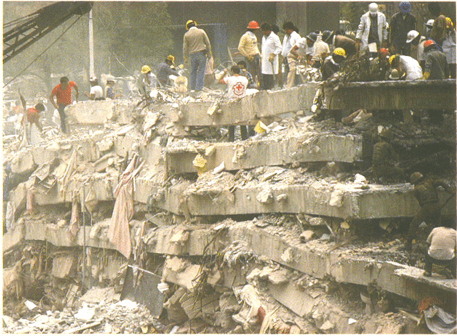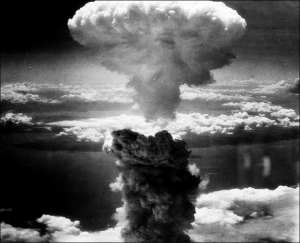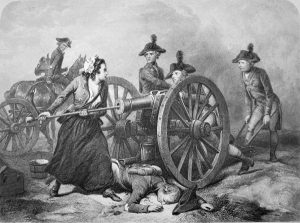“It is 7:19 am with 32 seconds central Mexico Time. It is still shaking a little, but let’s remain calm and wait a second so we can—…” These were the last words the people of Mexico City heard from Lourdes Guerrero, the face of Televisa’s morning news before their televisions cut to static. The next ninety seconds would not only change Mexico City forever but it would define a whole generation’s governmental standards.1
For the people of the Mexican capital, Thursday September 19, 1985 began like any other day. It was 53 degrees; the sky was clear, and at just a little after 7:00 am, children were arriving at schools, adults were going to work, and the city was beginning to wake up for another day.2 Suddenly at 7:19 am, the worst earthquake to ever strike the city unleashed on the Mexican people, and for ninety seconds, the capital experienced the full force of mother nature. Measuring 8.1 on the Richter scale, the earthquake moved whole concrete buildings and crushed entire apartment complexes, effectively trapping the people inside.3

Prior to the arrival of the Spaniards in 1521, the Aztecs had built their capital, Tenochtitlan, over Lake Texcoco. “Over the years, this man-made island has paid the price for building over a lake with soft soil. Every year since its establishment, Mexico City has been steadily sinking into the fragile soil,” and when earthquake waves arrive in the areas around the city, they are amplified by a factor of 100, causing the damage to be worse than it would be in any other soil.4 On the morning that terror struck, Mexico City felt the magnitude of an earthquake that developed off the coast of Michoacán. The earthquake waves reached the capital with a magnitude of 8.1 on the Richter scale, but created much greater damage than any other earthquake before.5
After the earthquake, the citizens began to assess the damage and the long and difficult road towards recovery. Almost instinctively, they started moving rocks and debris from people and liberating some who were trapped.6 Within hours, the citizens noticed the poor response from the government, especially from president Miguel De la Madrid, who had not publicly spoken about the tragedy. As the day went on, the number of people missing increased as well as the impatience of the citizens as police and the military were unable to get organized and froze, leaving the relief efforts completely in the hands of the citizens.7
In the north of the city, the General Hospital had lost its entire OBGYN (obstetrician and Gynecology) wing, trapping mothers who had just given birth as well as their new born babies. Sylvia Reyna, a nurse working at the hospital, gave her testimony about how doctors, nurses, and anyone who was willing to help rushed to start looking for survivors. “Every time someone got out alive, we cheered and celebrated with happiness, but when we pulled a lifeless body, everyone was silent.”8 Scenes like this one were not isolated. All throughout the city there was more than 100,000 homes and buildings destroyed by the earthquake that ultimately trapped people inside. Famous city landmarks, like the famous Regis Hotel and the country’s most important television network headquarters, had been crushed, ultimately cutting the city’s most important form of communication with the outside world. Although the death toll for the first day is still unknown, many believe the number is in the tens of thousands.9

With over 250,000 people left without a home, and no response from the government, the citizens united to take over the search and rescue to find those who were missing.10 Women brought pots and pans and cooked for the volunteers, doctors and nurses created makeshift hospitals to treat the injured, and crime was controlled by the citizens. The first 24 hours after the earthquake put incredible pressure on the government to respond, and as media outlets around the world started spreading the news of the earthquake, the pressure put on the president was raised.
Without the government’s assistance, various groups like the now famous Topos de Tlatelonco formed in order to help dig out people. Although nowadays the Topos are an established organization famous for their heroic assistance all around the world, in 1985 they were just a citizen-based group volunteering to help the people still trapped inside the buildings. During the terrible earthquake in 1985, these men and women earned the nickname “topos,” which means “moles,” for their incredible ability to go into the rubble to help those inside. Today, more than thirty years after the tragedy in Mexico City, this official organization has traveled all across the world to help in disasters, such as the earthquake in Haiti in 2010, and the Tsunami in Indonesia of 2004.11
The progress of the initial day was incredibly inspiring as hundreds of people had been rescued and the city was united to overcome the terrible tragedy. However, they were not prepared for the 7.1 magnitude aftershock that arrived 36 hours after the initial quake. On the evening of September 20, as many citizens dug in the ruins of apartment complexes and wandered around the city looking for their loved ones, the capital was struck with another earthquake that completely halted the recovery and forced many to start over. The aftershock made the buildings that had earlier collapsed settle, which made it much harder to rescue those who were still trapped. Although the damage from the second quake was incalculable, the second earthquake left citizens more afraid and scared than the first one. Citizens once again flooded the streets and dropped to their knees to pray for it to stop.12
With yet another earthquake, and pressure from his people, President Miguel De la Madrid first spoke publicly about the earthquake three entire days after the initial earthquake happened. His response outraged the citizens as De la Madrid downplayed the number of injured and dead in front of the world media and refused to accept aid from countries around the world who offered to help.13 One of his initial responses was also to send the military and police to disrupt the progress citizens had made by blocking off many buildings and restricting access to volunteer groups such as the Topos de Tlatelonco. By doing so, he effectively stopped the search and rescue of hundreds of individuals who were still trapped and injured days after the quake.14 His actions only angered the people more, and many citizens recalled the soldiers actively looting in the ruins of hotels and apartment buildings, taking all the safe boxes and jewels they could find.

Although the exact death toll was never given, some estimate it to be between 10,000-40,000.15 In the aftermath of the historic earthquake, the government was forced to implement building safety codes and regulations as well as an early-earthquake alarm system to ensure people will get out of structures safely. Similarly, after incredible pressure from citizens and other countries, Mexico ultimately accepted help from the United States, insuring that people would receive the much needed help. Nowadays in Mexico City and in the surrounding municipalities, people continue to regularly practice evacuation. Schools and offices hold earthquake drills regularly to ensure the events of 1985 won’t happen again.
The citizens did their best to move on, and return to normalcy as soon as possible. Despite living among the incredible destruction, they went to mass, they returned to work, they began reconstruction and prayed for those who were still missing. Now more than thirty years after the terrible events brought the capital to its knees, the damaged areas show no evidence of the destruction, with only monuments left to remind them of the tragedy that took place.16
- Encyclopedia of Latin American History and Culture, June 2008, s.v. “Earthquakes,” by Jürgen Buchenau. ↵
- “Weather history for MMMX Thursday September 19, 1985,” Weather underground, Accessed April 12, 2018. https://www.wunderground.com/history/airport/MMMX/1985/9/19/DailyHistory.html?&reqdb.zip=&reqdb.magic=&reqdb.wmo=. ↵
- Elena Poniatowska, Nothing nobody: the voices of the Mexico City Earthquake (Philadelphia, Temple University press, 1995), 13. ↵
- Michael Kimmelman, “Mexico City, parched and sinking, faces a water crisis,” The New York Times (New York City, NY), February 17, 2017; Lucy Jones, interview by Judy Woodruff, PBS News Hour: Why Mexico City is vulnerable to earthquakes, September 20,2017. ↵
- Historical Dictionary of Mexico, 2008, s.v. “Earthquake of 1985,” by Marvin Alisky. ↵
- Alan Riding, “A year after the quake, Mexico City Is on the mend,” The New York Times (New York City, NY), September 20, 1986. ↵
- Daniel Hernandez, “The 1985 Mexico City Earthquake, Remembered,” Los Angeles Times, September 20, 2010. ↵
- Elena Poniatowska, Nothing nobody: the voices of the Mexico City Earthquake (Philadelphia, Temple University press, 1995), 19. ↵
- Encyclopedia of Urban Studies, 2010, s.v. “Mexico City, Mexico: History of the city,” by Adrian Guillermo Aguilar and Ailasa Winton. ↵
- Encyclopedia Britannica, September 20, 2017, s.v. “Mexico City earthquake of 1985.” ↵
- “Historia,” Brigada de rescate Topos de Tlatelonco, accessed April 10, 2018. http://www.topos.mx/nosotros/historia. ↵
- Rosalía Guerrero, interview by Guillermo Guerrero, La replica del 20 de Septiembre de 1985, Chilango, September 18, 2015. ↵
- Elena Poniatowska, Nothing nobody: the voices of the Mexico City Earthquake (Philadelphia, Temple University press, 1995), 24. ↵
- “El Universal,” Miguel De La Madrid, El Presidente ‘ausente’ En Tragedia Del 85 | Red Política – El Universal. September 19, 2004. Accessed April 13, 2018. http://www.redpolitica.mx/nacion/miguel-de-la-madrid-el-presidente-ausente-en-tragedia-del-85. ↵
- Alan Riding, “A year after the quake, Mexico City Is on the mend,” The New York Times (New York City, NY), September 20, 1986. ↵
- David Adler, “The Mexico City earthquake, 30 years on: have lessons been forgotten?,” The Guardian (Mexico City, Mexico), September 18, 2015. ↵



47 comments
Ysenia Rodriguez
Wow, I cannot believe Mexico’s President Miguel De la Madrid could ever do such disrespectful actions to stop volunteers from helping families, at the very least, get closure from finding trapped loved ones. As I read the article, I could not help but think of the United States’ current response to the Puerto Rico disaster and how President Trump has tried to convince the U.S. that the death toll is not that big a deal. I do not understand how leaders can offer no assistance to the people who elected them into position. It’s terrifying and quite infuriating.
Clarissa Gonzalez
I was aware of this earthquake, but knew none of the things that actually occurred, the details of the tragedy. The political area of the president of Mexico was something I didn’t know about the situation. It angered me that he didn’t do anything for his people and lied to his surviving citizens. I really enjoyed how this article was structured. A good read for sure!!
Michael Othon
Mexico City is a beautiful place that gets ruined by earthquakes at times. This article shed light on the mexican government at times of need for its citizens. it’s sad to know that the citizens had to do everything themselves, because the government didn’t help at all. I’m glad that they came through to help themselves instead of waiting on help that would never arrive.
Daniela Cardona
I feel like Mexico has pretty bad luck with government based on the articles I have read on the site. It’s sad to think about a president belittling his people and considering other factors, like appearance, more than the safety of his people. The good thing is very necessary laws came out of the quake that have put Mexico in a safer place than it was before. I do hope that at some point Mexico gives justice to those who lost their lives and puts out a more accurate death count.
Dylan Sanchez
Wonderful article not only concerning the reason why Mexico City has such a vulnerability when it comes to earthquakes, but also emphasizes on the fact that the president did not do much to aid his own people. I find it inspiring how the citizens were the ones who went on to help each other in this gruesome time of need. I also liked how they went to mass, school, work etc.after the unfortunate event. Such a hard-working and helping people.
Maisie Favila
Although I do remember hearing about this earthquake later on during one of my classes, I didn’t nearly know half of the information this article gave me. It’s so devastating to read about and I can’t imagine what they truly went through. I thought it was crazy how President Miguel De la Madrid had spoken out about the devastation days later. It made me upset finding out that he refused aid from other countries and didn’t speak truthfully. I liked the article because not only did it give me background info on the earthquake but it made me curious about similar situations.
Jose Fernandez
I did know about this earthquake before reading the article, but I didn’t know many details. The article is very organized and well written. I think the author does a great job telling the story and building de tension. I particularly liked the beginning. This natural disaster was a very serious one and had many fatalities. It is sad because the people couldn’t do anything to protect themselves. It reminds me to be grateful of what I have.
Montserrat Moreno Ramirez
An unforgettable date for the Mexican people. It was such a devastating date, many lives were lost and destroyed. In Mexico City after this awful disaster, many lost their houses and had extremely difficult time recovering from all that had happen, but it was good to know that people cared enough. They helped for several months by bringing food, helping children, building emergency houses and even foreign countries helped to reestablish the city and help the citizens overcome this tragedy.
Harashang Gajjar
The devastation it caused in Mexico City was a result of the unstable foundation of much of the city, the bed of Lake Texcoco. When a quake strikes, it’s like shaking a bowl of jelly, the website Geo-Mexico observed this week in its report on the 1985 event.Damage was estimated to total US $4 billion; 880 structures were left in ruins. Most of the damage was seen in four boroughs — Venustiano Carranza, Cuauhtémoc, Benito Juárez and Gustavo Madero.Although the quake was felt in many other parts of Mexico, there was little damage. One exception was Ciudad Guzmán in Jalisco: more than half the city’s buildings were destroyed and 50 people diedToday, Mexico City residents commemorated the 1985 disaster with an earthquake drill, marked by the sounding at 11:30 of the city’s seismic warning system, delivered by more than 8,000 loudspeakers located throughout the Federal District.
Enrique Segovia
An earthquake with a magnitude of 8.1 on the Richter scale, is bound to cause severe damage to everyone. Even more so, the death toll was sure to be high given that Mexico City is such a densely populated city, prompting even more damage to the people and the land. Also, I find it horrible that the government was so unreliable in this scenario, and it is inhumane that they could have saved many lives and prevented many injuries, but they decided not to. I had heard about this earthquake when I was a small child, but I am disgusted that the Mexican government could have prevented the loss of many lives, but they did not.